Business Decision Making - Assignment
Added on 2021-06-15
38 Pages5876 Words24 Views
Running head: BUSINESS DECISION-MAKING
Business Decision-Making
Name of the Student:
Name of the University:
Author’s Note:
Course ID:
Business Decision-Making
Name of the Student:
Name of the University:
Author’s Note:
Course ID:

1BUSINESS DECISION-MAKING
Table of Contents
Introduction:....................................................................................................................................3
Task 1: Planning the survey.............................................................................................................4
a) Data collection plan:................................................................................................................4
b) Survey methodology and sampling frame used:.....................................................................5
c) Questionnaire for data collection:............................................................................................6
Task 2: Summarisation and analysis of data....................................................................................9
a) Analysis using measures of central tendency:.........................................................................9
b) Analysis of the survey results:...............................................................................................10
c) Analysis using measures of dispersion:.................................................................................16
d) Use of percentiles, quartiles and correlation coefficient to draw useful conclusion:............17
Task 3: Presentation and reporting of findings..............................................................................18
a) Use of graphs for making valid survey conclusion:..............................................................18
b) Trend lines in spreadsheet graphs for showing the level of impact over three-year period:.21
c) Poster presentation:................................................................................................................23
d) Formal report for publication:...............................................................................................24
Task 4: Software-generated information to make business decisions...........................................24
a) Characteristics and role of various management systems in a business:...............................24
i/ Transaction processing systems (TPS):..............................................................................24
Table of Contents
Introduction:....................................................................................................................................3
Task 1: Planning the survey.............................................................................................................4
a) Data collection plan:................................................................................................................4
b) Survey methodology and sampling frame used:.....................................................................5
c) Questionnaire for data collection:............................................................................................6
Task 2: Summarisation and analysis of data....................................................................................9
a) Analysis using measures of central tendency:.........................................................................9
b) Analysis of the survey results:...............................................................................................10
c) Analysis using measures of dispersion:.................................................................................16
d) Use of percentiles, quartiles and correlation coefficient to draw useful conclusion:............17
Task 3: Presentation and reporting of findings..............................................................................18
a) Use of graphs for making valid survey conclusion:..............................................................18
b) Trend lines in spreadsheet graphs for showing the level of impact over three-year period:.21
c) Poster presentation:................................................................................................................23
d) Formal report for publication:...............................................................................................24
Task 4: Software-generated information to make business decisions...........................................24
a) Characteristics and role of various management systems in a business:...............................24
i/ Transaction processing systems (TPS):..............................................................................24
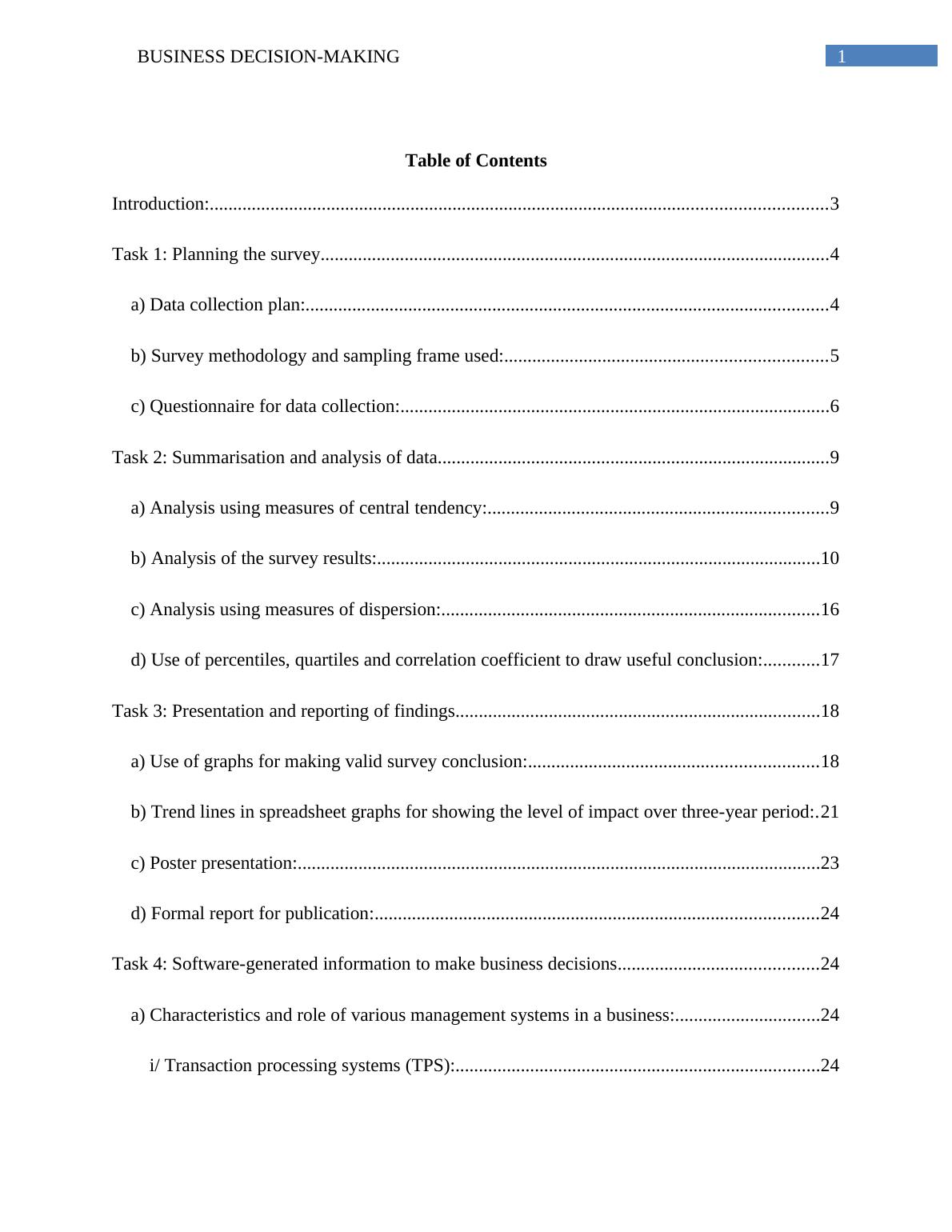
2BUSINESS DECISION-MAKING
ii. Management information systems (MIS):.........................................................................25
iii. Decision support systems (DSS):.....................................................................................26
b) Network diagram and critical path:.......................................................................................27
c) Financial tools for decision-making:.....................................................................................29
d) Net present value (NPV) of the project:................................................................................29
e) Internal rate of return (IRR) of the project:...........................................................................30
Conclusion:....................................................................................................................................30
References:....................................................................................................................................32
ii. Management information systems (MIS):.........................................................................25
iii. Decision support systems (DSS):.....................................................................................26
b) Network diagram and critical path:.......................................................................................27
c) Financial tools for decision-making:.....................................................................................29
d) Net present value (NPV) of the project:................................................................................29
e) Internal rate of return (IRR) of the project:...........................................................................30
Conclusion:....................................................................................................................................30
References:....................................................................................................................................32
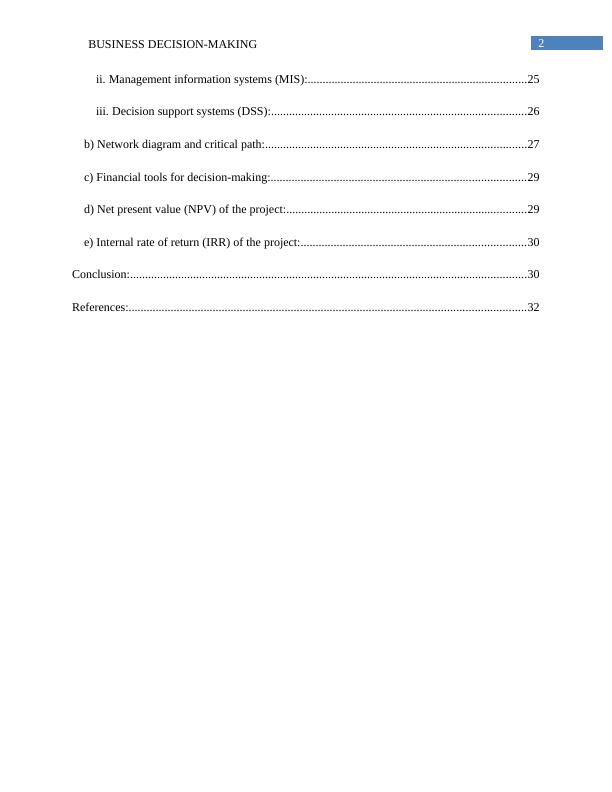
3BUSINESS DECISION-MAKING
Introduction:
In the current era, the business organisations function in the competitive environment for
which it has become difficult for them to sustain competitive advantage in the market and as a
result, decline could be observed in their efficiency levels. Moreover, the management is
required to undertake certain decisions associated with all the departments and growth of the
organisations. Hence, decisions are required to be undertaken at all levels of management, which
include tactical, strategic and operational level. Along with this, without evaluating the market
conditions, it becomes difficult for an organisation in undertaking suitable decisions and this
might act as hurdle in fulfilling the set targets and objectives (Choy 2014). For this current paper,
the high street malls and shops are taken into consideration and the aim is to analyse the impact
of online shopping sites on them. This is due to the changes in attitudes, tastes and preferences of
the customers in relation to purchase intentions and through this, such malls and shops could
undertake suitable decisions (Panneerselvam 2014). This study covers several tasks like
designing plan for collecting primary as well as secondary data, survey methodology and others.
The overall structure of this assignment is designed in the form of a figure as follows:
Introduction:
In the current era, the business organisations function in the competitive environment for
which it has become difficult for them to sustain competitive advantage in the market and as a
result, decline could be observed in their efficiency levels. Moreover, the management is
required to undertake certain decisions associated with all the departments and growth of the
organisations. Hence, decisions are required to be undertaken at all levels of management, which
include tactical, strategic and operational level. Along with this, without evaluating the market
conditions, it becomes difficult for an organisation in undertaking suitable decisions and this
might act as hurdle in fulfilling the set targets and objectives (Choy 2014). For this current paper,
the high street malls and shops are taken into consideration and the aim is to analyse the impact
of online shopping sites on them. This is due to the changes in attitudes, tastes and preferences of
the customers in relation to purchase intentions and through this, such malls and shops could
undertake suitable decisions (Panneerselvam 2014). This study covers several tasks like
designing plan for collecting primary as well as secondary data, survey methodology and others.
The overall structure of this assignment is designed in the form of a figure as follows:
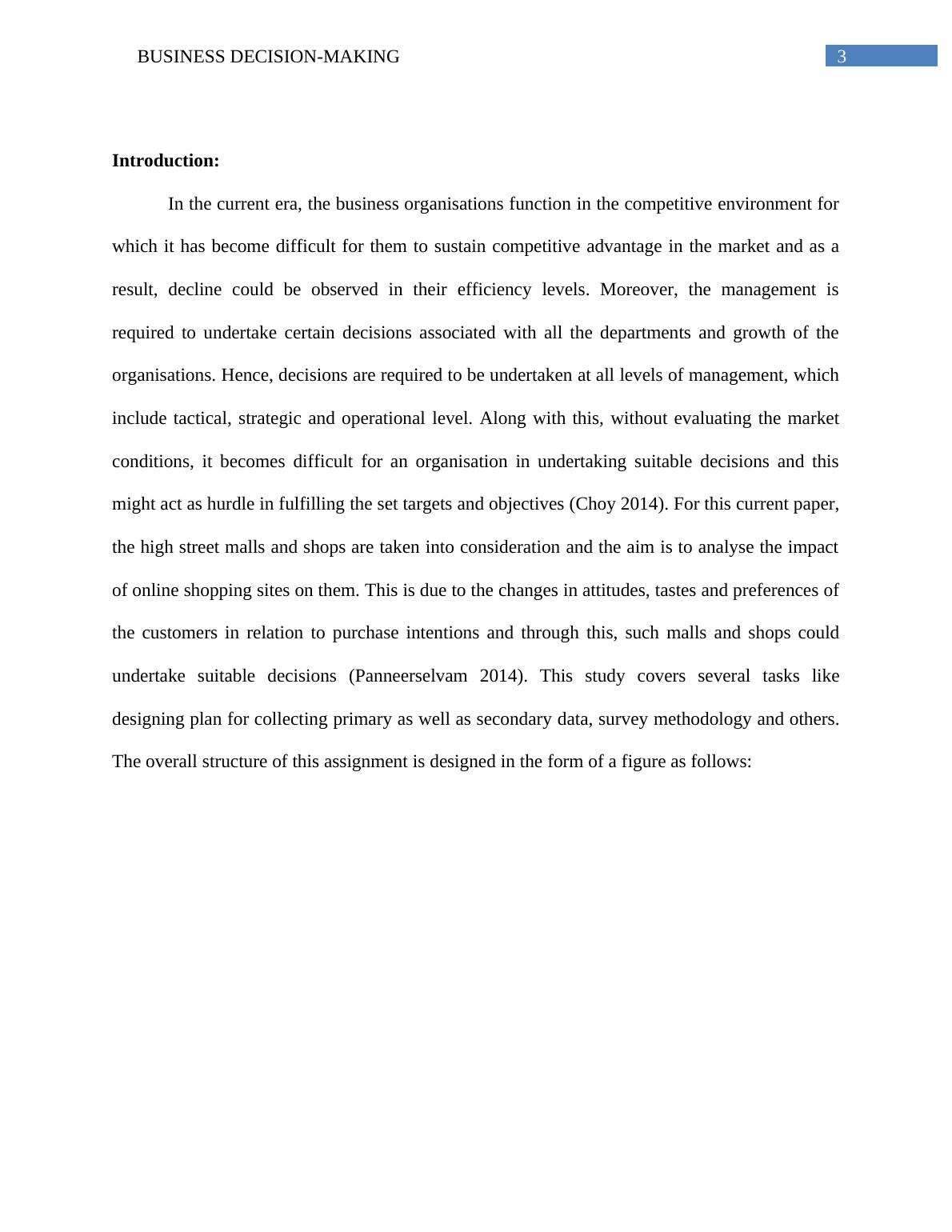
4BUSINESS DECISION-MAKING
Questionnair
e design
Application of
relevant
methods
Accumulation
of necessary
data
Use of
representative
values
Presentation
through
graph and
trend lines
Making
appropriate
inference
Data structure
through
dispersion
measures
Project plan
and critical
path
Validity
measurement
through analytical
tools
Figure 1: Information process chart of the research
(Source: As created by author)
Task 1: Planning the survey
a) Data collection plan:
For making suitable decisions, it is essential for gathering information from primary as
well as secondary sources so that the retail firms operating in high street malls and shops could
enhance their overall market performance. The focus of these organisations is to differentiate
their products and services from the online shopping sites. The primary stress of the management
is to improve the efficiency, capture overall growth and steer the top line (Taylor, Bogdan and
Questionnair
e design
Application of
relevant
methods
Accumulation
of necessary
data
Use of
representative
values
Presentation
through
graph and
trend lines
Making
appropriate
inference
Data structure
through
dispersion
measures
Project plan
and critical
path
Validity
measurement
through analytical
tools
Figure 1: Information process chart of the research
(Source: As created by author)
Task 1: Planning the survey
a) Data collection plan:
For making suitable decisions, it is essential for gathering information from primary as
well as secondary sources so that the retail firms operating in high street malls and shops could
enhance their overall market performance. The focus of these organisations is to differentiate
their products and services from the online shopping sites. The primary stress of the management
is to improve the efficiency, capture overall growth and steer the top line (Taylor, Bogdan and

5BUSINESS DECISION-MAKING
DeVault 2015). Hence, by considering primary as well as secondary data, the organisations could
understand the customer perceptions regarding their shopping behaviours.
Plan for collection of primary data:
In order to gather primary data, the online survey technique has been taken into account
and well-structured and close-ended questionnaire has been designed. This would help in
understanding the attitudes and tastes of the customers towards their purchasing intentions from
the online platforms. The researcher has framed 10 questions including age and gender group of
the participants and Likert scale has been used for conducting the overall research. Due to all
these primary reasons, the accumulation of primary data is considered highly effective and this
would lead to the achievement of intended objectives and targets (Mackey and Gass 2015).
Plan for collection of secondary data:
In order to gather secondary information, references are made from the published books,
journals and statistical websites. Moreover, the industry reports are taken into consideration as
well to identify the trends of the customers towards online shopping (Flick 2015). All such
information accumulated would help the retail stores to undertake effective decisions so that
their sales revenues are increased in the market.
b) Survey methodology and sampling frame used:
Survey methodology:
In order to carry out the survey effectively, the campus students from various colleges
and universities of UK are taken into consideration. The primary goal of conducting this survey
is to ascertain the attitudes, behaviours and preferences of the customers towards online shopping
DeVault 2015). Hence, by considering primary as well as secondary data, the organisations could
understand the customer perceptions regarding their shopping behaviours.
Plan for collection of primary data:
In order to gather primary data, the online survey technique has been taken into account
and well-structured and close-ended questionnaire has been designed. This would help in
understanding the attitudes and tastes of the customers towards their purchasing intentions from
the online platforms. The researcher has framed 10 questions including age and gender group of
the participants and Likert scale has been used for conducting the overall research. Due to all
these primary reasons, the accumulation of primary data is considered highly effective and this
would lead to the achievement of intended objectives and targets (Mackey and Gass 2015).
Plan for collection of secondary data:
In order to gather secondary information, references are made from the published books,
journals and statistical websites. Moreover, the industry reports are taken into consideration as
well to identify the trends of the customers towards online shopping (Flick 2015). All such
information accumulated would help the retail stores to undertake effective decisions so that
their sales revenues are increased in the market.
b) Survey methodology and sampling frame used:
Survey methodology:
In order to carry out the survey effectively, the campus students from various colleges
and universities of UK are taken into consideration. The primary goal of conducting this survey
is to ascertain the attitudes, behaviours and preferences of the customers towards online shopping

6BUSINESS DECISION-MAKING
in contrast to the retail shops operating in UK (Silverman 2016). Along with this, in order to
carry out online survey, the students of UK are contacted via e-mail with the designed set of
questions. Hence, with the help of this survey methodology, it is possible to collect suitable
primary information which could support in meeting the objective of the research as well
(Vaioleti 2016).
Sampling frame:
Sampling frame is related to choosing the sample size from which the data needs to be
accumulated. In order to collect information, probability sampling in the form of simple random
sampling has been used, in which every student has the equal opportunity of being chosen in
order to provide information regarding their choice of platforms for purchasing products
(Ledford and Gast 2018). The sample size of 30 students has been chosen irrespective of all ages.
Hence, by considering the students of various campuses in UK, exact and up-to-date information
could be gathered through which suitable business decisions could be undertaken (Humphries
2017).
c) Questionnaire for data collection:
1. Tick your gender:
Male
Female
2. Tick your age group:
Less than 18 years
18-25 years
in contrast to the retail shops operating in UK (Silverman 2016). Along with this, in order to
carry out online survey, the students of UK are contacted via e-mail with the designed set of
questions. Hence, with the help of this survey methodology, it is possible to collect suitable
primary information which could support in meeting the objective of the research as well
(Vaioleti 2016).
Sampling frame:
Sampling frame is related to choosing the sample size from which the data needs to be
accumulated. In order to collect information, probability sampling in the form of simple random
sampling has been used, in which every student has the equal opportunity of being chosen in
order to provide information regarding their choice of platforms for purchasing products
(Ledford and Gast 2018). The sample size of 30 students has been chosen irrespective of all ages.
Hence, by considering the students of various campuses in UK, exact and up-to-date information
could be gathered through which suitable business decisions could be undertaken (Humphries
2017).
c) Questionnaire for data collection:
1. Tick your gender:
Male
Female
2. Tick your age group:
Less than 18 years
18-25 years
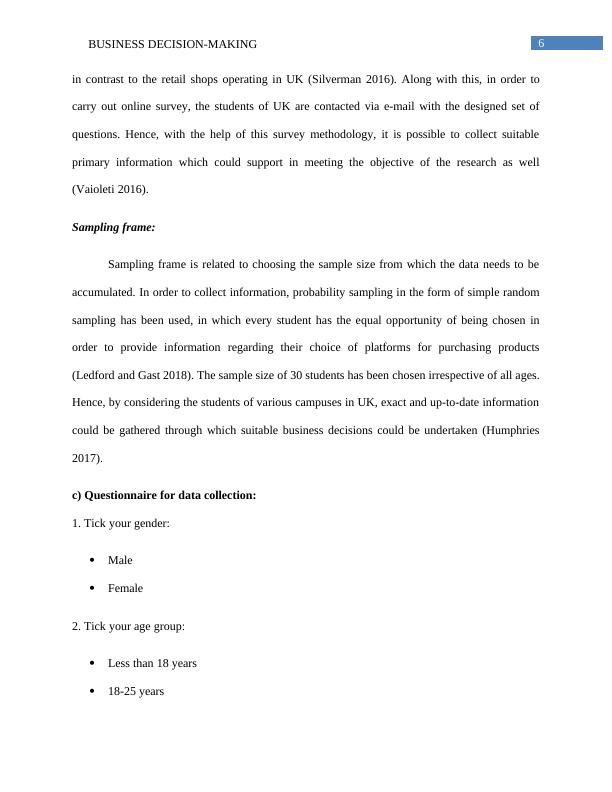
7BUSINESS DECISION-MAKING
26-35 years
36-45 years
46 and above
3. Which product(s) do you prefer to shop frequently?
Groceries
Cosmetics
CDs/DVDs
Clothes
Computer Products
Others
4. What platform do you use to purchase products?
Online shopping sites
High street shops and malls
5. How often do you use internet in a day?
Less than one hour
1-2 hours
2-3 hours
3-4 hours
More than 4 hours
6. Are you satisfied with the pricing structure of the products available in the online shopping
sites?
26-35 years
36-45 years
46 and above
3. Which product(s) do you prefer to shop frequently?
Groceries
Cosmetics
CDs/DVDs
Clothes
Computer Products
Others
4. What platform do you use to purchase products?
Online shopping sites
High street shops and malls
5. How often do you use internet in a day?
Less than one hour
1-2 hours
2-3 hours
3-4 hours
More than 4 hours
6. Are you satisfied with the pricing structure of the products available in the online shopping
sites?
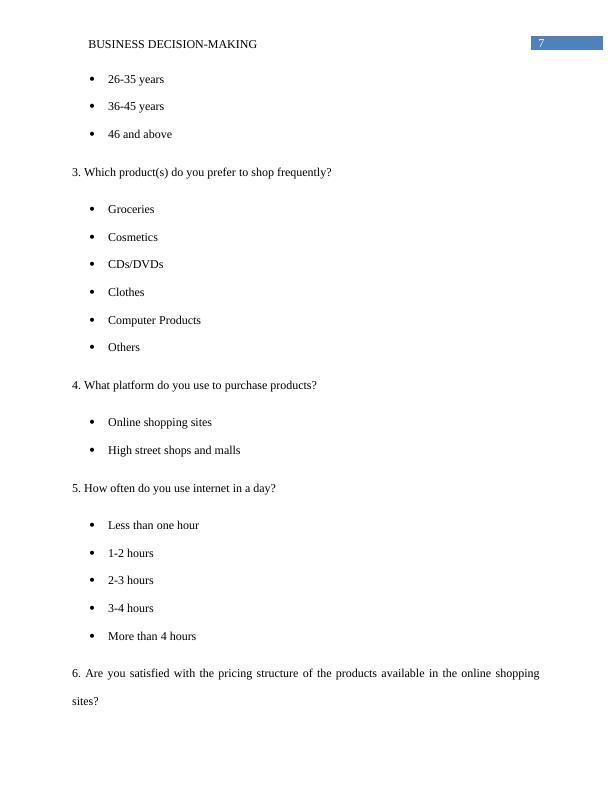
End of preview
Want to access all the pages? Upload your documents or become a member.
Related Documents
Impact of Technological Innovation on Queensgate Shopping Centrelg...
|16
|3507
|21
Report on Impact of Technological Innovations - Queensgate Shopping Centrelg...
|12
|3455
|56
Business Decision Makinglg...
|22
|3855
|95
[PDF] Business Decision Making Assignmentlg...
|16
|3599
|174
Assignment on Business Decision Making (pdf)lg...
|16
|3625
|141
(Doc) Business Decision Making Assignmentlg...
|24
|4856
|27
